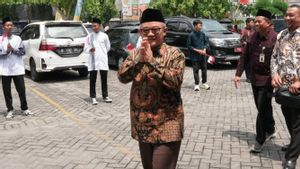JAKARTA - In a dynamic business environment and competition is getting tighter, employee productivity is a key factor in the company's success. One method to increase productivity is through coaching programs. Coaching is a continuous coaching process that aims to achieve individual and organizational goals. In this approach, a coach cooperates with employees to overcome obstacles that hinder the achievement of goals, both in terms of professional and personal.
This article will explain about coaching, the different types of existing coaching, the benefits of coaching processes, as well as the steps in the implementation of coaching itself. Our goal is to introduce coaching as an employee training method, which aims to increase productivity in the work environment. Together, we will understand how coaching can be a very effective means for individual career development and ultimately make a positive contribution to the success of the company.
Coaching is a guidance process that facilitates individuals to develop skills and achieves their maximum potential, both in a professional and personal sphere. Based on research from Harvard Business Review, coaching opens up opportunities for two-way performance between guides and individuals who are being guided, who are often referred to as coaches.
In the business environment, coaching is considered an effective approach to improve performance, adaptation to change, and leadership development. This not only involves increasing technical capabilities but also developing interpersonal skills and decision making abilities. Coaching also plays a role in helping individuals identify and take advantage of their strengths and overcome weaknesses, which ultimately contribute to increased productivity and job satisfaction.
Employees
Coaching plays a role in helping employees recognize and explore essential self-potentials in the development of individual careers. This process spurs motivation and commitment, enables employees to act more independently and achieve a higher level of job satisfaction. Through coaching, employees receive constructive feedback to improve performance and improve overall skills.
For Companies
Coaching has a positive impact on team performance and strengthens relationships in the work environment, which contributes to the creation of a harmonious work atmosphere. Long-term advantages for the company include increasing employee engagement and achieving more efficient business targets. With the effective implementation of coaching, the company will also experience increased profitability thanks to better individual and team performance.
In the realm of coaching, there are various types that are adapted to the specific needs of individuals or teams. Coaching is divided into several main categories:
1. Executive Coaching
Concentrating on leadership and managerial development. Executive training helps individuals who have a managerial responsibility to adapt to new roles or address performance problems.
2. Team Coaching
Aiming to improve team coordination and effectiveness. Through team training, team members learn to use their resources more efficiently and achieve synergies in work.
3. Directive Coaching
An experienced manager provides direct direction regarding the tasks that must be done, very useful for developing specific skills.
4. Non-Directive Coaching
Stressing on the development of individual wisdom and creativity through dialogue and deep questions, allows individuals to find their own solutions to the challenges they face.
5. Situational Coaching
Combining a direct and non-directive approach depends on the situation it faces, allowing flexibility in the coaching method.
6. Laissez-Faire Coaching
Give employees the freedom to carry out their duties with a little intervention, effective in teams that are already independent and efficient.
Each type of coaching is designed to meet specific needs in the work environment, helping individuals and teams reach their full potential.
1. Planning
Managers and coaches work together to determine the goals and targets of coaching and plan the action to be taken to achieve that goal.
2. Observation
Coach made observations of managers' performance in real work situations to identify strengths and weaknesses.
3. Feedback
Based on observational results, coach provides feedback to managers to help improve their capabilities and performance.
4. Training and Training
The manager takes part in training and training to practice the skills that have been accepted during the coaching process, aiming to improve capabilities and performance.
5. Evaluation
Managers and coaches evaluate coaching results to determine whether goals and targets of coaching have been achieved.
6. Follow-up
The follow-up process is carried out to ensure managers continue to improve their capabilities and performance, as well as practice the skills they have received during the coaching process.
Through the explanation contained in this article, we can gain a deeper understanding of how coaching can stimulate employee productivity by giving them the opportunity to develop the best potential they have. The benefits are not only felt by employees in terms of personal development and careers, but also provide significant benefits for companies in achieving competitive advantages. With the right coaching approach, both individuals and teams will be encouraged towards achieving the best achievements, which will ultimately improve the overall performance of the company.
This increase in productivity can only be achieved by effective and systemed training methods. In this context, Associate plays an important role as a strategic partner in helping employee coaching processes to improve employee abilities. Prioritizing quality and adaptive training methods, Associate provides solutions that not only increase work efficiency but also build a more positive and productive work environment. Through the integration of strategic plans and the effective implementation of coaching, advanced steps in achieving productivity expectations in the workplace are increasingly affordable and tangible.
1. How to effectively increase employee work productivity?
To increase employee work productivity, several steps that can be taken include providing tasks that are in accordance with HR interests and capabilities, building effective two-way communication, creating a comfortable work atmosphere, conducting training or job training programs, involving employees in sharing ideas with companies, and creating closeness events.
2. How can coaching improve employee performance?
Coaching can help your team members improve their performance and skills in certain fields, such as communication, problem solving, or teamwork. This is an effective way to develop potential employees.
3. What is coaching in the context of employee development?
Coaching is a professional development strategy that aims to improve individual skills and abilities in their work. Coaching not only focuses on improving individual performance, but also helps employees achieve their full potential through structured guidance, support, and constructive feedback.
4. What are the main benefits of the coaching program?
One of the main benefits of the coaching program is its ability to bring out a person's potential. Through the coaching process, a coach will help provoke coachee's thoughts (coaching people) so that coachee can think and find solutions to the problems she faces.
The English, Chinese, Japanese, Arabic, and French versions are automatically generated by the AI. So there may still be inaccuracies in translating, please always see Indonesian as our main language. (system supported by DigitalSiber.id)













